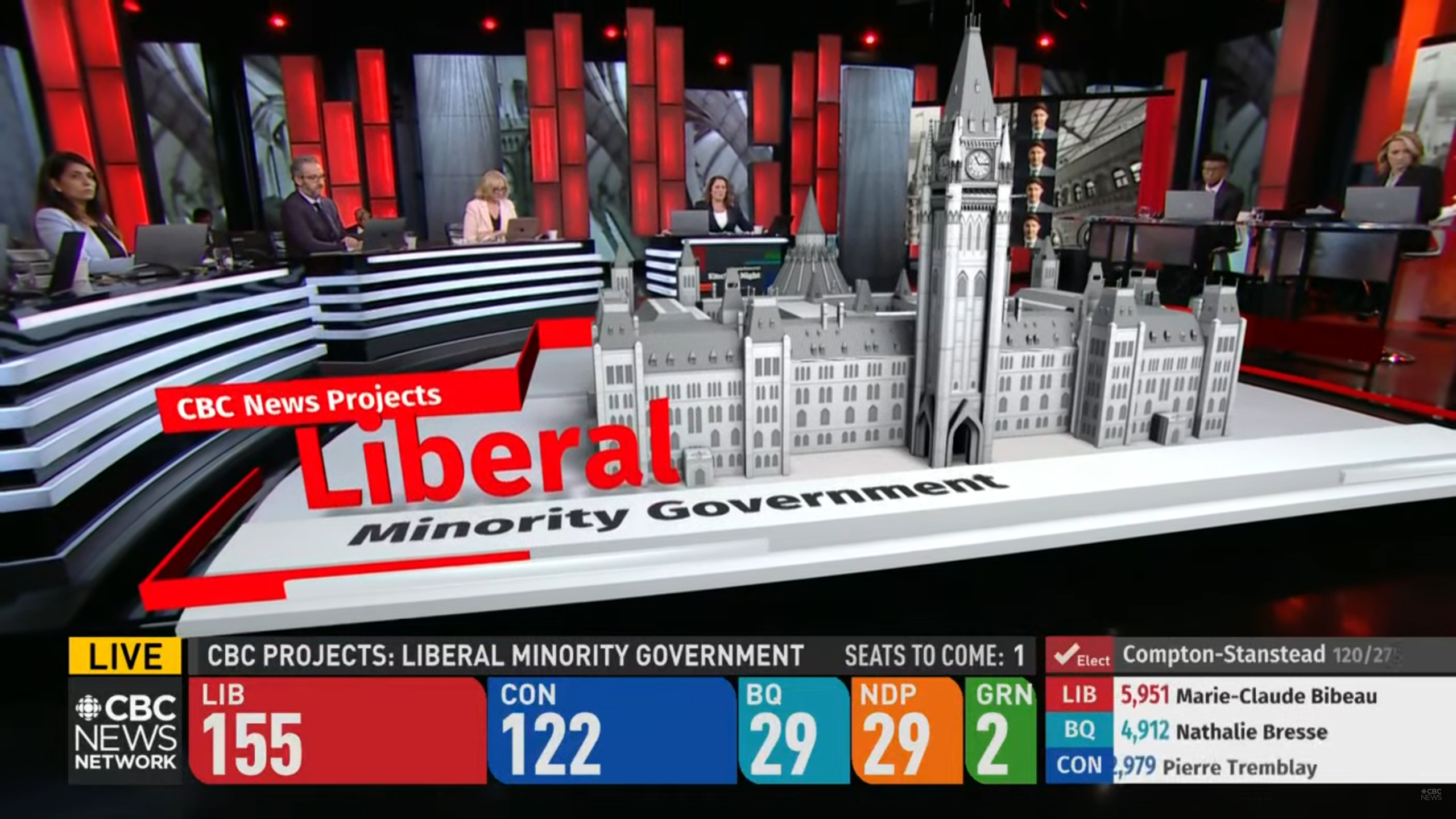Canadian Prime Minister Justin Trudeau may not end up with the majority he was hoping to regain when he orchestrated the dissolution of the House of Commons a few weeks ago, but it appears that he and his party will at least emerge from today’s snap election no worse off than they were before.
As initial results rolled in, the CBC projected a Liberal Government, concluding that the available data indicates that Trudeau will remain Prime Minister and at least secure a plurality when all of the ballots are counted.
As of press time, the Liberals led in one hundred and fifty-four ridings (that’s what Canadians call a district), while the Conservatives, under the leadership of Erin O’Toole, led in one hundred and twenty-two ridings.
The Bloc Québécois led in twenty-nine ridings, the left-wing New Democratic Party led in twenty-nine ridings, and the Green Party led in two.
The numbers are fluctuating as new tabulations continue to be released.
As of dissolution, the parties’ numbers were as follows:
- Liberals: 155
- Conservatives: 119
- Bloc Québécois: 32
- NDP: 24
- Green: 2
If you’re not familiar with Canadian politics, here’s a quick primer on the parties.
- The Liberals are the current governing party in Canada, and have formed government since 2015. Led by Justin Trudeau, the party leans more to the left, but is not the most progressive major party in the country. The party is socially liberal, but more right wing on environmental issues.
- The Conservatives are the main right wing party in Canada, but are not as extreme or militant as the Republican Party in the United States. They are currently led by Erin O’Toole, who tried to woo progressive Canadian voters away from the Liberals with some reasonable platform planks.
- The New Democratic Party is the biggest true left wing party in Canada. It is currently led by Jagmeet Singh and espouses progressive positions across all the major issues. The NDP has never performed well enough in a federal election to form a government in Her Majesty’s name, but sibling party organizations at the provincial level have won majorities before, most recently last year in British Columbia under John Horgan.
- The Green Party is a staunchly pro-environment party that, as its name suggests, is focused principally on combating pollution, taking climate action, and implementing reforms to reduce corruption. The party has never had more than three seats in the House of Commons. It won its first seat in ten years ago when party leader Elizabeth May was elected in Saanich — Gulf Islands, a Vancouver Island riding.
- The Bloc Québécois is a Quebec-only party led by Yves-François Blanchet that favors the political secession of Quebec from Canada. It has been characterized as socially democratic and separatist. The Bloc was formed thirty years ago and has seen its numbers shrink and grow dramatically over the course of many federal elections.
In the popular vote, the Conservatives currently have 33.9%, the Liberals have 33.1%, the NDP has 16.6%, the Bloc has 8.1%, the People’s Party has 5.1%, and the Greens have 2.1%. (The People’s Party is a far right wing party that currently has no seats in Parliament and isn’t slated to win any tonight.)

“It looks like nobody wanted an election and nobody got what they wanted,” remarked Chantal Hébert, speaking to the CBC. “Justin Trudeau doesn’t get his majority, the Conservatives do not get the government… the NDP, I think, would have liked to be in control of the balance of power, that’s not happening, and the Bloc Québécois did not get the bump they hoped for in the polls.”
As in the last few elections, the main battlegrounds are urban Ontario (the Greater Toronto Area, also known as the GTA), Quebec, and metropolitan Vancouver, in British Columbia. The Liberals are doing just fine in GTA and reasonably well in Quebec, which accounts for their plurality showing so far tonight.
But they have not repeated their strong showing from 2015, when they roared back to power and knocked out Stephen Harper’s government.
Rosy pre-writ polling did suggest that the Liberals might be able to secure a majority in a snap election, but once Trudeau actually pulled the trigger, O’Toole’s Conservatives proved to be more competitive than the Liberals had expected.
In many public opinion surveys taken in recent weeks, the Conservatives have either been tied with the Liberals, or not far behind.
The final preelection polling showed the Liberals pulling away a bit, leaving them with breathing room to avert electoral disaster, but short of their objective.
The big winner in this election could be the New Democratic Party (NDP).
Two years ago, the NDP won just twenty-four seats in the first election under new leader Jagmeet Singh. At present, the NDP is ahead in twenty-nine ridings, which would represent an increase of nearly half a dozen seats.
The Bloc, meanwhile, looks like it could end up with a few fewer seats than it won in the 2019 federal election. The Bloc had aspirations of winning more than forty seats, so this result will likely come as a disappointment to the Bloc and its supporters, but they are at least avoiding being wiped out as they were in 2011.
If you’d like to follow along as the leaders make their election night appearances and results become more firm, there are several livestreams you can choose from:
Trudeau is reportedly going to speak at 9:30 PM Pacific Time.

